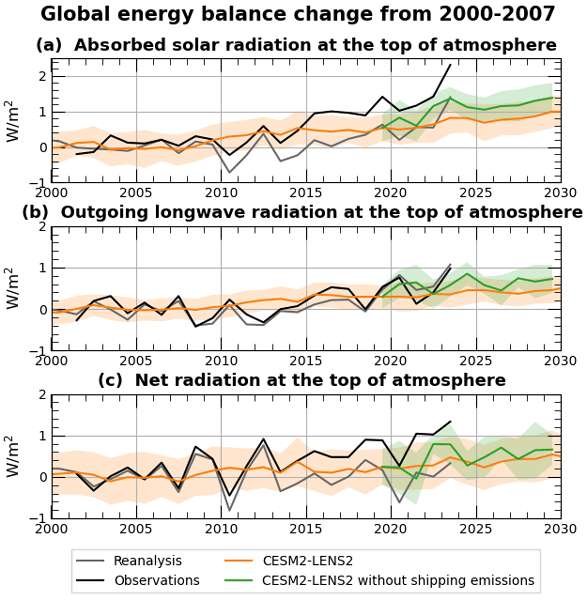The summer of 2023 saw an unexpected rise in global temperatures, which caught many climate scientists by surprise.
While global warming driven by greenhouse gases has been a known issue, this sudden spike was not predicted by most models.
“Climate scientists were saying this is essentially impossible, that it is bonkers to see such a jump all at once,” said Daniele Visioni, assistant professor in the Department of Earth and Atmospheric Sciences at Cornell University. “People were saying, ‘Climate change is suddenly accelerating.’ We’d never seen something like this.”

The study, led by Visioni and his co-author Ilaria Quaglia, a postdoctoral researcher at Cornell University’s Sibley School of Mechanical and Aerospace Engineering, provides an explanation.
Published in Earth System Dynamics, the paper links the surge in global temperatures to the reduction in sulfate emissions from international shipping, following a regulation enforced by the International Maritime Organization (IMO) in 2020.
The IMO’s 2020 regulation aimed to lower the sulfur content of shipping fuels from 3.5% to 0.5%, cutting sulfur oxide emissions significantly. While this change improved air quality, it had an unintended effect on the climate by reducing the amount of aerosols — specifically sulfate particles — that help form clouds. These clouds play a key role in reflecting solar radiation back into space, helping to cool the planet.
As sulfate emissions dropped, cloud cover in key shipping areas also decreased. With fewer clouds reflecting sunlight, more heat was absorbed by the Earth’s surface, contributing to the higher-than-usual temperatures seen in the summer of 2023. The study’s simulations suggest that the reduction in sulfate emissions may have raised global temperatures by about 0.08°C.
The paper’s findings suggest future policy decisions around abrupt reductions in tropospheric aerosols should take into account their surface temperature impact.
The researchers stress that their findings should not be seen as an argument against pollution reduction efforts, but rather a reminder of the complex nature of climate systems. Visioni emphasizes that improving air quality is important.
“Air quality improvement is immediate, and everyone is always going to go for that. A lesson here is we make decisions about trade-offs all the time,” he said. “We are reducing air pollution more than was predicted 10 years ago, so there needs to be a lot more open discussion. It means the urgency of emission reduction is even greater.”
The shipping industry had been aware of the IMO’s sulfate reduction rules for several years, following a 2014 decision. Shifting to low-sulfur fuels, which are more expensive, proved difficult, and the transition took time. However, by 2020, the industry largely complied with the new sulfur content limits, resulting in an over 80% reduction in sulfur oxide emissions.
“There was no attempt to say we should have all eyes on the shipping corridor,” Visioni said. “In hindsight, it would have been great to study that four years ago before the problem manifested itself.”
The study’s model simulations examined global temperature anomalies from 2020 to 2023, adjusting for greenhouse gas contributions and seasonal changes. The researchers found that the removal of sulfur dioxide from shipping fuel contributed to a temperature increase of around 0.08°C. Once this factor was accounted for, the record heat of 2023 appeared to follow the normal warming trend, rather than representing an acceleration.
Although this increase was modest, it was enough to be noticed in the record high temperatures of 2023. The study suggests that changes in aerosol emissions — whether from shipping or other sources — can have significant impacts on global temperatures, even if they are unrelated to traditional greenhouse gas emissions.
Visioni points out that this is not a call to reverse pollution-reduction efforts, but rather a reminder of the complexity involved in environmental regulations. “We are reducing air pollution more than was predicted 10 years ago, so there needs to be a lot more open discussion,” Visioni said. “It means the urgency of emission reduction is even greater.”
The study also examines ways to mitigate the warming caused by such regulatory changes. As the shipping industry moves toward alternative fuels such as methanol, hydrogen, ammonia, and wind-assisted propulsion, Visioni urges faster action on emissions reductions.
“We need to be more forceful about emissions reductions,” he said. “We have to bridge a gap. But we should work to prevent warming of the planet through other means. Cloud brightening, geoengineering climate interventions – these are not things that are going to reduce emissions, but they are things we might need to prevent further warming.”
Visioni’s comments highlight the ongoing challenge of balancing pollution reduction with climate action. As global efforts to curb emissions continue, the study serves as a reminder of the need for careful consideration of the potential consequences of even well-intended regulatory changes.
Journal Reference:
Quaglia, I. and Visioni, D., ‘Modeling 2020 regulatory changes in international shipping emissions helps explain anomalous 2023 warming’, Earth System Dynamics 15, 1527–1541 (2024). DOI: 10.5194/esd-15-1527-2024
Article Source:
Press Release/Material by Cornell University
Featured image credit: tawatchai07 | Freepik




